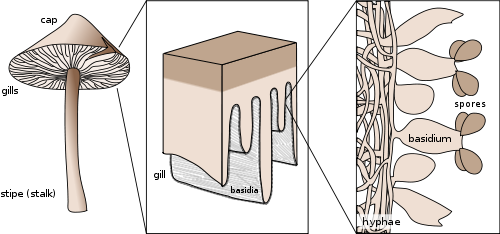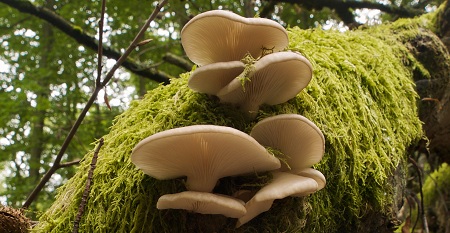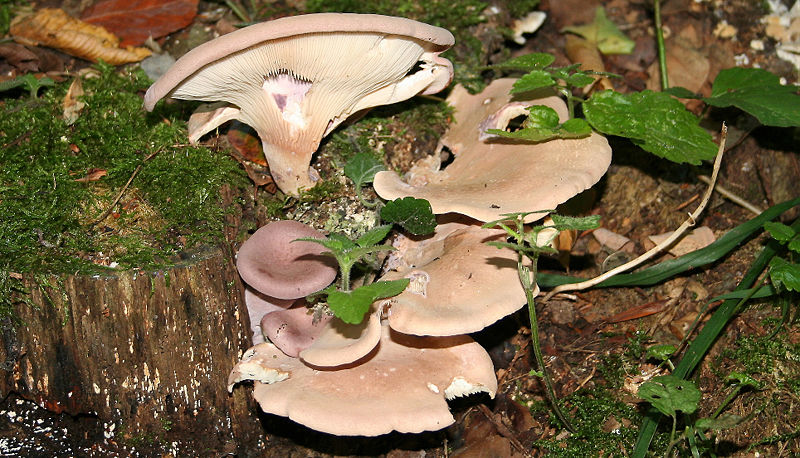Classification
Domain: Eukarya
Members of Eukarya are characterized by the
presence of membrane bound organelles and a true nucleus bound by a
nuclear envelope. This stands in contrast to the Bacteria and
Archaea, who lack these features.
Examples:
Datura stramonium, Jimson Weed,
Photeros annecohenae, Bioluminescent Ostracod
Kingdom: Fungi
Fungi are heterotrophs that exhibit alternation of
generations, meaning that both the diploid and haploid stages of its
life cycle exhibit multicellularity. They have chitinous cell wall
and reproduce via spores.
Examples:
Cordyceps sinesis, the Caterpillar Fungus,
Rhizopus stolonifer, Black Bread Mold
Phylum: Basidiomycota
The basidiomycota bear their sexual spores
externally on club shaped structures called basidia. This is a
scanning electron micrograph of the basidia and basidiospores of
Pleurotus ostreatus.
Example:
Lycoperdon pyriforme, the Wolf-Fart Puffball

Gilled fungi have their basidia on their gills.
The extra surface area that gills give them enables them to produce
many times more spores.
Class: Agaricomycetes
The agaricomycetes are mushroom producing fungi.
Most mushroom producing fungi are members of this class, with morels
and truffles being the exception as members of the phylum ascomycota.
Example:
Ganoderma lucidum, Reishi Mushroom
Order: Agaricales
The agaricales are traditionally known as the gilled mushrooms, but new research suggests that the agaricales are more diverse, as gills have evolved in multiple instances within the agaricomycetes. The macroscoping grouping of gilled mushrooms is not monophyletic, so the agaricales are a phylogenetically defined class.
Example: Psilocybe cubensis, the Magic Mushroom
Family: Pleurotacea
Pleurotaceae is a family gilled mushrooms, most of whom are saprotrophic on wood substrate with some members of the family able to derive nutrition from nematodes. I've come across older literature that classifies P. ostreatus with the tricholomataceae or the agaricaceae, but one again, the phylogenetic research linked above shows that this is a misplaced classification.
Genus: Pleurotus
All members of the genus Pleurotus are nematophageous with most being saprotrophic on wood. The fruiting bodies are usually flat with the cap offset from the stalk, or the stalk hardly present at all. The spores leave a lilac, grey, or white spore print.

Pleurotus pulmonarius is
morphologically very similar to Pleurotus ostreatus
Species: Pleurotus ostreatus
Pleurotus ostreatus (roughly translating to "beside-the-ear oyster-shaped") predominantly grows on hardwoods throughout North America, Europe, and Asia. It has a pale lilac-grey spore print and a soft fleshy fruiting body that ranges in color from white to grey, brown or even blackish. There's some variability among the species due to the wide distribution and reproductive isolation between continents.

Pleurotus ostreatus sprouting from a log in Belgium.
Note: Always be careful when attempting to identify edible fungi based on morphological characteristics and eat nothing that you're not absolutely sure about. For example, the poisonous Australian fungus, Omphalotus nidiformis bears similarity to some edible members of Pleurotus, so care should always be exercised.
As mentioned above, there are familial relationships and similarities in how P. ostreatus acquires it's food, so click here to move onto the nutrition page.
